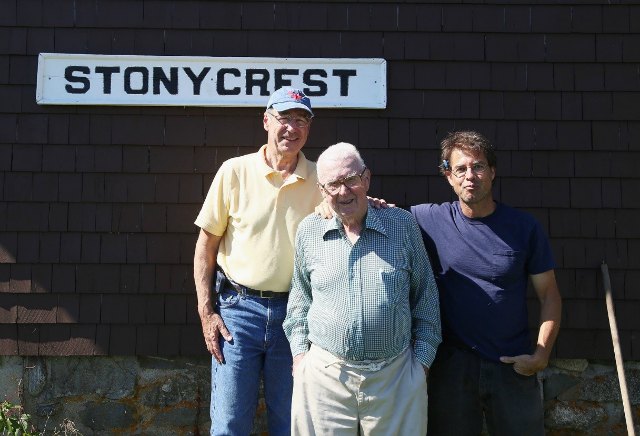
pictured L to R: Dave Lowell; Gene Dalrymple; PMM’s Matt Wheeler
Gene Dalrymple would probably not be considered a native by some people’s reckoning, but his 97-year association with Marshall Point in Port Clyde, Maine, makes him a local by ours. Dalrymple grew up outside of Boston, but his maternal grandfather was the last keeper at Marshall Point Light during the US Lighthouse Service era; his tenure there (July 1874 to May 1919) was the longest in the history of the Service. Dalrymple’s mother was born in the lighthouse; his family were at home when the original mortared stone keeper’s house was struck by lightning in 1895 (there were no casualties but the building itself, which had to be replaced).
Gene himself was born in the cottage pictured above, which was built on land his grandfather bought on the Point. He travelled with his mother by steamer from Boston each summer to spend the warm months at Port Clyde. A historian by nature, Gene has an ear for stories and a keen interest in the people around him. Throughout his adulthood, as a dentist whose primary residence was in Camden, Dalrymple continued to return to this peninsula, a working port and a summer haunt for many, including luminaries such as the three generations of painterly Wyeths. Dave Lowell, a former Tenants Harbor resident and a friend of PMM’s, made Gene’s acquaintance over a period of years; he encouraged a meeting, knowing that our photography holdings included a generous lode of old Port Clyde images. Since many of our images are undescribed, we jumped at the chance to hear more about this richly-storied place. Starting in 2013, with Gene’s guidance and with the enthusiastic participation of several other local elders, we began to piece together a narrative.
The effort has brought us to the point of planning a Port Clyde photo book. The book will include wide views of the harbor with labels identifying historic homes and businesses, street scenes, photos of local buildings—homes, hotels, businesses which are local landmarks or are no longer standing—and waterfront views. Its captions will recall a thriving center of commerce and the characters who made the place lively and memorable. There’s still a lot of work to do, including further interviews with additional sources. As Gene exhorts us, “This thing has got to be 110% right”. We agree. The prospect of revealing this world before it succumbs to the blurring of time excites us. Stay tuned.

